Application of whey for tomatoes
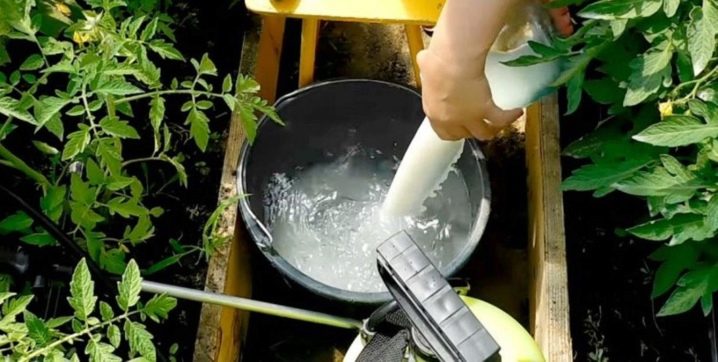
Whey has long been used for many household purposes. One of the effective options for using the product is spraying fruit and vegetable crops against pests and diseases.
How does the serum work?
In the garden plots, the owners want to grow organic products, but not everyone knows how to fight plant diseases and feed them without the help of agricultural chemicals. There are safe agronomic practices based on simple and affordable organic products such as whole raw milk and whey.
Of the many garden crops, tomatoes respond particularly well to the use of fermented milk products in the process of growing them. As a result of the use of this nutritive protein substance, the quality of the fruits and the yield of plants are noticeably increased.
Spraying tomatoes with serum can be carried out no more than 1 time in 2 weeks.
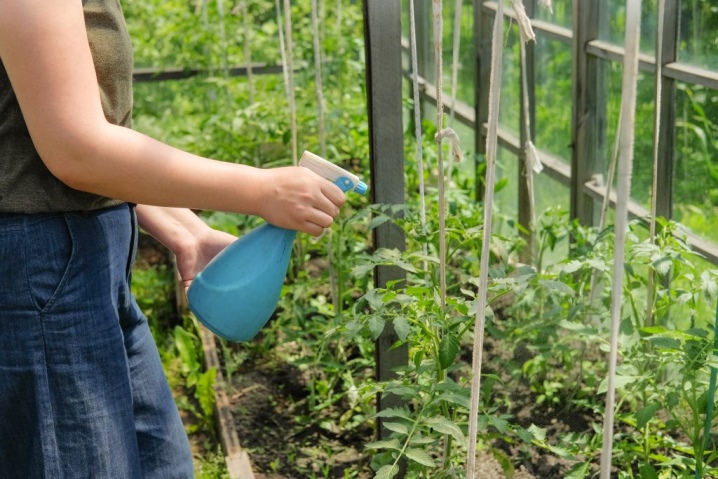
Milk whey diluted with water, which is usually obtained in rural farms from the production of cottage cheese, should not be pasteurized. Raw, natural foods contain many more nutrients and vitamins. Spraying and feeding with serum is carried out in the form of root and foliar irrigation. How useful such procedures are for tomatoes can be judged by the decrease in the number of empty flowers and the appearance of numerous ovaries on the bushes.
Treating tomato bushes with whey greatly strengthens the plant and provides it with many nutrients to enhance its natural immunity.... Milk and derived products contain lactose, which helps to resist pests, and various amino acids are an irreplaceable nutrient medium for the growth and fruiting of a garden crop. Milk diluted with water, when sprayed on the leaves, creates a layer on their surface that protects the plant from many insects and fungal diseases.
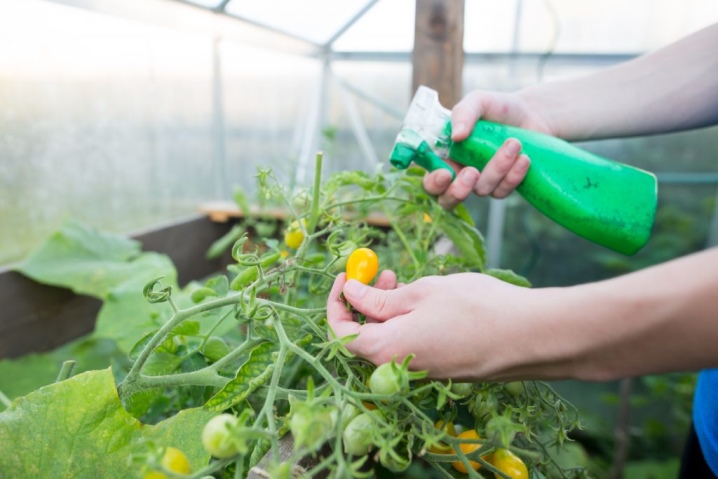
The uniqueness of the composition of whey in its saturation with microelements. Among them:
- iron;
- magnesium;
- calcium;
- copper;
- potassium.
Together with amino acids, they affect the growth of a powerful root system, regulate sap flow, increase the resistance of tomatoes to adverse weather conditions and stimulate hormonal development during flowering.
Getting into the soil, lactic acid bacteria accelerate the decomposition of organic fragments in it, contributing to the formation of a fertile layer.

How to prepare the solution?
Absolutely harmless to plants and humans, tomato feeding is prepared on the basis of whey.... To do this, natural cow's milk must turn sour, for which it is placed in a warm place, covered with gauze. To speed up the souring process, you can add a few tablespoons of sour cream or kefir to milk. The fermented mass should be heated over low heat to separate into cottage cheese and whey.
To process tomatoes, you cannot use full-fledged fermented milk products, milk and whey must be diluted with water purified from bleach, in a ratio of 1 to 10. Too concentrated solutions can disturb the acid-base balance of the soil. For better retention of the solution on the foliage, you can add a little laundry soap, crushed and dissolved in warm water, into it.Many fans of experimental, environmentally friendly farming do not stop at using pure whey with water for growing vegetables, but enhance the solutions with other useful additives.

With iodine
Lactic acid, the content of which is abundant in whey, is a reliable protection of plants against various fungal diseases, such as:
- leaf spot;
- powdery mildew in the form of white spots;
- late blight of tomatoes;
- rust and scab.
Among the pests that a solution of whey helps to fight in a ratio of 1 liter of product to 3 liters of water are insects such as cruciferous flea and onion midge. Spraying is carried out in the morning once a month. In cases where the spread of late blight becomes critical, a solution of 1 liter of serum, 8 liters of water and 20 drops of iodine can be used.
Liquid with iodine helps the plant not only to successfully cope with fungal diseases, but also strengthens the immunity of tomatoes, performing the task of fertilizing, rich in microelements.
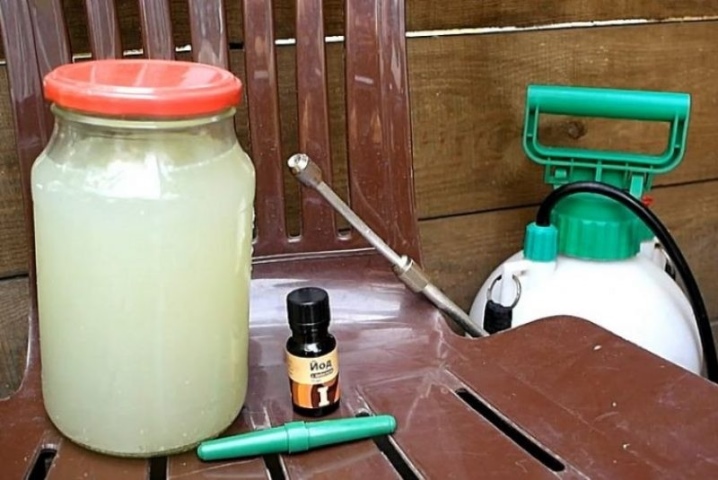
With honey
Beekeeping products have a wide range of useful effects, like dairy products. Solutions with the addition of honey are a good nutrient for tomato bushes, and also attract pollinating insects during flowering. To prepare a spray mixture, dilute 10 liters of water with 1 liter of whey and dilute there 5 tablespoons of honey.
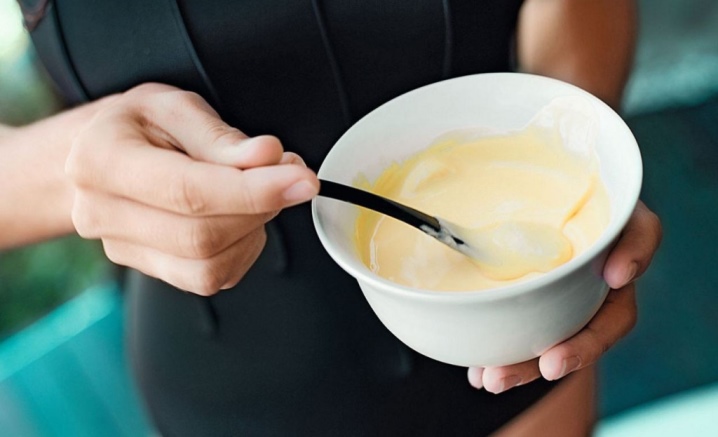
With yeast
Yeast and whey are valuable nutritional products for stimulating the growth of garden crops in their own right, but when combined, their beneficial qualities are increased. The whey-added liquid enriches the enzymes that yeast is rich in, resulting in a powerful organic stimulant for stunted plants. To prepare this solution, you must first soak 100 grams of yeast in 1 liter of warm water, and then combine the resulting liquid with 1 liter of whey and 10 liters of water.
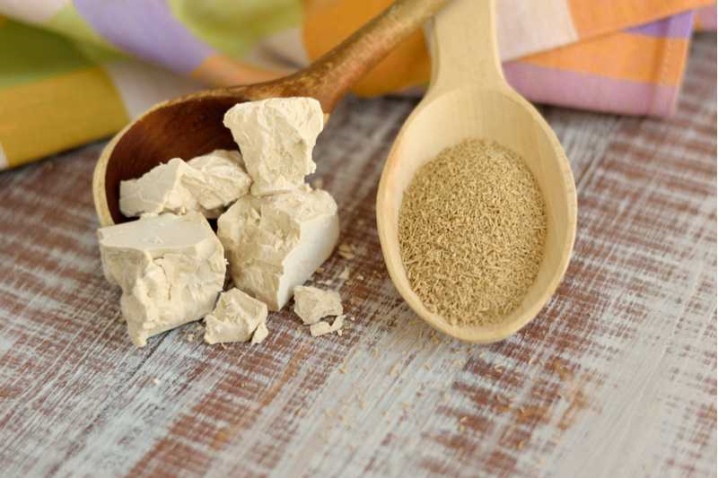
With boric acid
The effectiveness of the use of serum against fungal diseases on tomato plants can be enhanced by the addition of boric acid. To do this, half a teaspoon of boric acid must be stirred in hot water (about 100 ml), since it does not dissolve in cold water. Then add it to 1 liter of kefir or whey and dilute with 4 liters of pure water. Such a composition is suitable for spraying and watering, in the amount of 0.5 liters for each bush, after rain or preliminary application of moisture.
As a result of numerous field tests, it was found that the use of boron in the cultivation of vegetable garden crops increases their yield by an average of 30%.

Other recipe options
Top dressing of tomatoes will be very effective if you use fermented milk whey, iodine, boric acid, potassium permanganate, wood ash in various versions and proportions. Potassium permanganate, diluted to a deep pink color, has a strong antiseptic effect and destroys fungal spores of diseases. For the whole season, you can carry out up to 3 treatments.
Excellent results are obtained by summer residents who use a cocktail for foliar feeding of tomatoes. It consists of 100 grams of a hot solution of boric acid, 10 drops of iodine and a 2-liter can of ash left after burning firewood - for 1 bucket of clean and warm water.
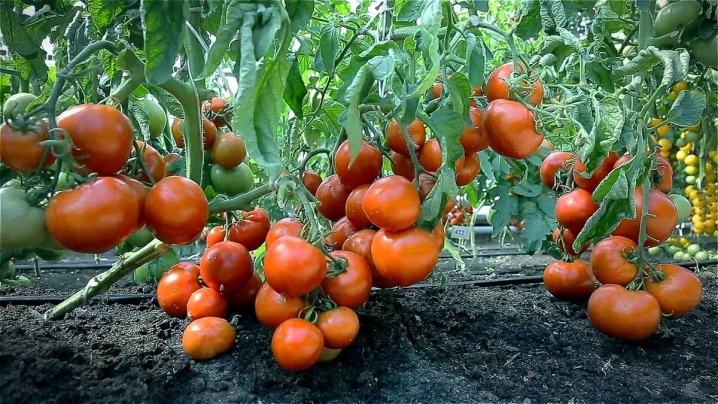
How to use?
Milk whey solutions prepared according to different recipes can be used to grow healthy tomato seedlings in the greenhouse and in the open field. You should not abuse it in such a strong and effective way - you can process and fertilize tomatoes only 3-4 times over the entire season. You should use lactic acid products for the garden:
- during the period of growing green mass;
- during flowering;
- to set fruit and reduce the percentage of barren flowers.
The treatment of plants with both chemical and folk preparations should be carried out correctly, according to a scheme defined and recommended by agricultural technicians. Only the application of the procedure, done on time and in sufficient quantity, can benefit living organisms, which are garden crops.
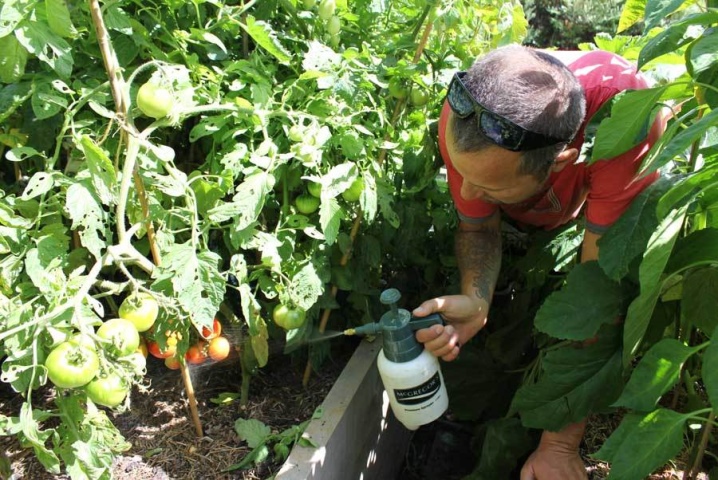
For seedlings
Young seedlings planted in open ground can be fed with a solution of serum with the addition of potassium permanganate and boric acid, which are especially beneficial for growth. Treatments at an early stage of development will help fertilize and protect plants from late blight. The next application of fertilizer based on dairy products is carried out at the stage of bush formation, in early July.
If necessary, the leaves are treated with the addition of iodine to the solution.

For adult plants
The grown bushes are treated during flowering by spraying them with a solution of serum with honey. In the midst of fruiting, you can water the bushes with various options for solutions prepared on the basis of milk whey, using both foliar and root types of dressings.
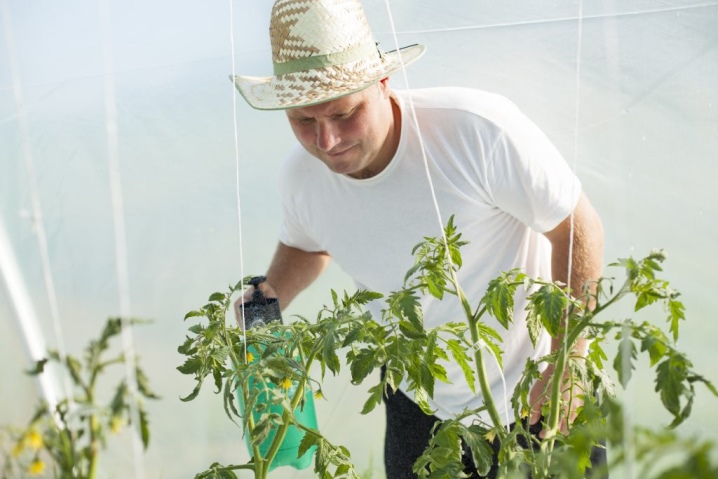













The comment was sent successfully.